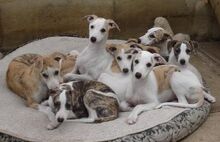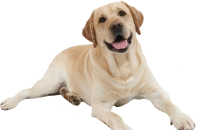Tag: Visual edit |
(Adding categories) |
||
| (One intermediate revision by one other user not shown) | |||
| Line 45: | Line 45: | ||
[[Category:Family Dogs]] |
[[Category:Family Dogs]] |
||
[[Category:Dog Breeds]] |
[[Category:Dog Breeds]] |
||
| + | [[Category:Hound Breeds]] |
||
| + | [[Category:Sight Hounds]] |
||
Revision as of 07:40, 9 May 2020


The Whippet (also English Whippet or Snap dog) is a dog breed of medium-size. They are a sighthound breed that originated in England, where they descended from greyhounds. Whippets today still strongly resemble a smaller greyhound. Shown in the Hound group, Whippets have relatively few health problems other than arrhythmia. Whippets also participate in dog sports such as lure coursing, agility, and flyball. The name is derived from an early 17th century word, now obsolete, meaning to ‘move briskly’.
Whippets were originally greyhounds that were deemed unsuitable for hunting because of their size. They were returned to their peasant breedersafter being maimed so that they could not be used to hunt and break the forest law. These maimed dogs were bred together and used to catch rats, and hunt rabbits. When the forest law was repealed, these "miniature greyhounds" became popular in the sport of dog racing. This has led to Whippets being described as "the poor man's racehorse." They are still frequently used as racing dogs today, as they have the highest running speed of breeds their weight: 40 miles per hour (64 km/h) and even challenge greyhounds for top speed. Whippets are, however, the fastest accelerating dog in the world.
History
Whippets were bred to hunt by sight, coursing game in open areas at high speeds. One can find numerous representations of small greyhound-like hounds in art dating back to Ancient Egyptian times. Pharaohs bred a small sighthound dog related to the greyhound to keep in their palaces, and this dog may be the ancestor of today's Whippets. In medieval England, a small greyhound breed became popular for use as a ratting dog. The first written English use of the word whippet with regard to a type of dog was in 1610. However, the first dog to be called a Whippet was actually a greyhound-spaniel cross and has little to do with the modern Whippet.
The original whippets were thought to be English Greyhounds that were too small for stag hunting in the forests of England. These dogs were frequently returned to their breeders, who were usually peasants and as such could not own hunting dogs under the forest law. Because of this, dogs returned to them were maimed, usually by cutting a tendon in a leg or removing the toes on one paw. The breeders kept these dogs and continued to breed them, producing a smaller version of a greyhound that was suited for rat catching and hunting hares and rabbits. When the forest law was repealed, the "small greyhounds" became immensely popular. Whippets were then commonly known as "snap dogs" for their tendency to "snap up" nearby prey. In the picture by Jean-Baptiste Oudry (1686–1755) of two dogs presented to Louis XV, they are either whippets or small greyhounds, but are probably related to an early form of whippet. Oudry also painted a second painting of Misse with a different, non-sighthound dog. There is a 1758 painting by Pompeo Batoni entitled Portrait of Charles Compton, 7th Earl of Northampton which features a similar whippet-like dog.
In the nineteenth century, Whippet racing was a major sport in England. The Whippet was held in high regard in the northern parts of England and Wales, but was generally disregarded in the rest of the country. At the time, there were two varieties of Whippet. The first type had a smooth coat, was more popular in Lancashire, Yorkshire, and the Midlands, and became the modern Whippet. The other had a rough coat from crossbreeding with Bedlington Terriers, was more popular in Durham and Northumberland and was frequently referred to as a "rabbit dog". Early specimens were taken from the race track by the dog fanciers of the time and exported around the world. John Taylor said that "In all the shapes and forms of dogges; of all which there are but two sorts that are useful to man's profits, which two are the mastiffe and the little curre, whippet, or house-dogge; all the rest are for pleasure and recreation."
The age of the modern Whippet dawned in 1891 when The Kennel Club granted the breed official recognition, thus making the Whippet eligible for competition in dog shows, and commencing the recording of their pedigrees. In the United States, the Whippet was recognised in 1888 by the American Kennel Club. Whippets arrived in the United States with mill operators from England, and the first populations were established in Massachusetts. The Whippet is the 55th most popular breed according to the American Kennel Club.
In 1964, Ch. Courtenay Fleetfoot of Pennyworth won best in show at the Westminster Kennel Club Dog Show. In 1992, Pencloe Dutch Gold won best in show at Crufts, and a Whippet known as Cobyco Call the Tune won in 2004. In 2011, GCh. Starline's Chanel, a female Whippet, was chosen as the hound Show Dog of the Year by the Westminster Kennel Club.
Racing
Dog racing was originally an extension of hare coursing. Whippets began to be bred to race in the mid-nineteenth century. The first form of the sport was a rudimentary form of coursing known as 'ragging', and dogs who participated were said to be 'trained to the rag'. Dogs were kept on a leash by a person known as a slip, who was frequently also the race judge. The slip would release the dogs from their collars at the same time, and they would race towards their owners, who were standing at the opposite end of the track waving towels.
Whippet rags were a popular Sunday event in the north and Midlands at the time. There were also international events; in Australia, at a track known as Gurney's Paddock, there were races of more than 300 whippets every Saturday, and three nights a week at the White City track. Eventually, the sport evolved and dogs were divided into four groups: those who hunted rabbits, which was not governed by rules; those who coursed hare, for which a set of rules was established; those trained to the rag; and those trained to chase a mechanical lure in a fashion similar to greyhound races. Few of the Whippets of any of the four types were purebred, as maintaining a purebred bloodline was not considered as important as breeding dogs that could win races. Many racing dogs were part terrier, part Greyhound, or part Lurcher.
In 1967, the British Whippet Racing Association was established to bring around reform and consistency in race rules and procedures for races involving non-purebred Whippets. A year later, viewing the non-purebred dogs as a threat, the Whippet Club Racing Association was established exclusively for purebred animals.
Description
Appearance
Whippets are a medium-sized dog weighing from 15 to 42 pounds (6.8 to 19.1 kg). There are two height ranges for Whippets, depending on whether or not the dog is being shown in North America. The Fédération Cynologique Internationale and The Kennel Club both call for heights of 18.5 to 20 inches (47 to 51 cm) for males and 17.5 to 18.5 inches (44 to 47 cm) for females. Whippets tend to be somewhat larger in the United States and Canada as the American Kennel Club and Canadian Kennel Club standards are larger; 18.5 to 22.5 inches (47 to 57 cm) for males, and 17.5 to 21.5 inches (44 to 55 cm) for females. Because colour is considered immaterial in judging Whippets, they come in a wide variety of colours and marking patterns, everything from solid black to solid white, with red, fawn, brindle, blue, or cream. The coat is short, smooth and close.
They are the fastest dog of their weight, capable of achieving speeds of 35 miles per hour (56 km/h). This is due to their unique way of running, which is referred to as a double suspension gallop. This gait results in four of the dog's legs being off the ground twice in each stride, once when the legs are completely extended and again when they are tucked under the body.
Temperament
Whippets are quiet and not prone to barking, but require regular exercise. They are generally gentle dogs and may be content to spend much of the day resting. The AKC describes them as "quiet and dignified in their owner's living room" and says they make "excellent house dogs." Whippets have been called a "poor man's racehorse" by the colliers in Lancashire and Yorkshire.
Despite being bred for racing, Whippets can be couch potatoes. When not running around, they are usually asleep or cuddled in their owner's lap. They are not prone to fighting but have been known to chase small pets, due to their sighthound nature. They also have a tendency to get up on furniture. Whippets are touch sensitive, meaning that they tend to jump or overreact when touched unexpectedly.
Health
Whippets course, work, and race; they have been bred for these jobs for years. This has kept them a structurally sound breed which is predominantly free from the physical exaggerations that can lead to certain health problems. Whippets are, like other sighthounds, intolerant of barbiturate anaesthetics. This is in part due to their low concentration of body fat and their liver's inability to metabolise the anaesthetics.
Given proper nutrition, exercise, and veterinary care, most Whippets live for 12 to 15 years. A UK breed survey puts the median lifespan at 12 years 10 months. They are generally healthy, and are not prone to the frequent ear infections, skin allergies, or digestive problems that can afflict other breeds. Genetic eye defects, though quite rare, have been noted in the breed. Because of this, the American Whippet Club recommends that breeders test for this defect in their breeding stock. Hip dysplasia is rare in Whippets, with only 1.2% of 161 evaluations performed by the Orthopedic Foundation for Animalsbeing determined as dysplasic.
The heart of a Whippet is large and slow beating, often being arrhythmic or even intermittent when the animal is at rest. This sometimes causes concern to the owner, or to the vet not experienced with the breed. Whippets will, however, demonstrate a regular heartbeat during exercise. In a health survey conducted by The Kennel Club cardiac problems were shown to be the second leading cause of mortality in Whippets.
A 2007 study identified a myostatin mutation particular to Whippets that is significantly associated with their athletic performance. Whippets with a single copy of this mutation are generally very fast; those with two copies have disproportionately large musculature and are known as "bully whippets". These bully whippets experience no significant health problems beyond those experienced by a normal whippet, but may be more prone to muscle cramping. The mutation has not been seen in Greyhounds or other sighthound breeds, or in heavily muscled dogs such as Bullmastiffs, Bulldogs, Rottweilers or American Staffordshire Terriers.
